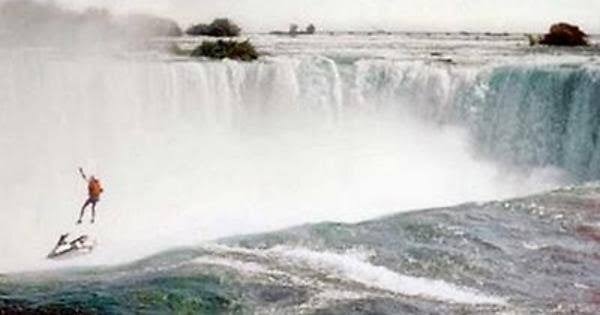Niagara Falls Claims Another Life in Failed Parachute Stunt
Niagara Falls Claims Another Life in Failed Parachute Stunt
Niagara Falls, July 1981
The raw power of Niagara Falls has long lured daredevils, thrill-seekers, and risk-takers from around the world. While most tourists are content to admire the majestic beauty from a safe distance, a select few have attempted to challenge nature’s fury—often with deadly consequences. One such tragedy occurred in July 1981, when a man’s parachute stunt went terribly wrong, turning a dramatic performance into a fatal plunge.
A Risky Dream
The man, identified as 38-year-old Robert Overcracker of California, was known among extreme sports enthusiasts and stunt performers. Charismatic and fearless, Robert had spent years performing stunts across the country, including high dives, motorcycle jumps, and skydiving exhibitions. His latest ambition, however, was his boldest yet: to ride a jet ski off the crest of Horseshoe Falls and parachute safely to the bottom.
His goal, he claimed, was to draw attention to the plight of the homeless in America—a cause close to his heart. But many suspected the stunt was also an attempt to gain notoriety in the growing world of extreme sports.
Overcracker arrived in Niagara Falls in the summer of 1981 with a support team, a modified jet ski, and a custom-built parachute system. He spent days scouting the river, monitoring weather conditions, and planning the precise location of his launch. Though warned repeatedly by local authorities and park officials not to attempt the stunt, Robert was determined to go ahead.
The Final Moments
On the afternoon of July 2nd, crowds began gathering along the Niagara Parkway on the Canadian side, just upstream of Horseshoe Falls. Word had spread quickly that a man was about to attempt the impossible. Tourists, reporters, and even law enforcement waited anxiously, unsure whether they were about to witness history—or disaster.
At around 3:20 p.m., Overcracker revved up his jet ski from a quiet area just beyond Goat Island. He wore a wetsuit, helmet, and a parachute rig strapped tightly to his back. Spectators watched in suspense as he sped toward the edge of the falls, riding directly into the fast-flowing current of the Niagara River.
As the jet ski reached the lip of the falls, it launched into the air, creating a stunning but terrifying image—Robert suspended momentarily above one of the most powerful waterfalls on Earth.
Then, the worst happened.
The parachute, which was supposed to deploy instantly upon launch, failed to open.
Witnesses described the scene as both shocking and surreal. “He just dropped like a stone,” said one tourist. “There was no chute, no sign of anything opening. It was horrifying.”
Overcracker plunged 167 feet (51 meters) into the churning basin below. Emergency crews were already on standby, but recovery was difficult due to the turbulence and foam created by the falls.
The Aftermath
Robert’s body was later recovered by the Maid of the Mist tour boat operators, near the base of the falls. His parachute was still strapped to his back, unopened.
News of the stunt gone wrong quickly made national headlines, sparking debates about the ethics of high-risk performances and the role of authorities in preventing such tragedies. While some called Robert a brave soul with a purpose, others criticized the act as reckless and self-serving.
“Robert believed in bringing attention to social issues through action,” said his sister, Linda Overcracker, in a statement. “He wasn’t crazy—he was passionate. He died doing what he loved.”
Niagara’s Legacy of Stunts
Overcracker was far from the first to challenge Niagara Falls—and sadly, he wouldn’t be the last. The falls have long held a unique place in the world of stunts and daredevilry.
In 1901, Annie Edson Taylor became the first person to go over Niagara Falls in a barrel and survive. She was 63 years old at the time.
In 1911, Bobby Leach attempted the same feat in a steel barrel and also survived, though he sustained multiple injuries.
In 1960, a 7-year-old boy named Roger Woodward accidentally went over the falls after a boating accident and miraculously survived wearing only a life jacket.
These tales of survival fueled interest in Niagara as a stage for extreme human feats—but the outcomes haven’t always been positive.
Over the decades, dozens of people have perished attempting stunts at Niagara Falls. Some were professionals, others were thrill-seekers, and a few were desperate individuals looking to make a statement. As technology improved and social media emerged, stunts like Overcracker’s were replaced by other forms of viral spectacle—but the risks remained the same.
Safety Measures and Legal Consequences
After the 1981 tragedy, the Niagara Parks Commission and local law enforcement began implementing stricter measures to deter dangerous activity around the falls. Surveillance, barriers, and signage were all upgraded to discourage unauthorized stunts.
Performing a stunt at Niagara Falls without a permit is now illegal on both the U.S. and Canadian sides, punishable by heavy fines and possible jail time.
“We understand the draw of the falls,” said a Niagara Parks spokesperson in a 2021 interview. “But it’s our job to protect people—from themselves, if necessary.”
Remembering Robert Overcracker
Despite the outcome, Overcracker remains part of Niagara Falls history. His story is told in daredevil museums, local tours, and documentaries about the many who have risked their lives for fame, purpose, or thrill.
A small plaque was erected near the observation deck on the Canadian side in his memory, reading:
“In memory of Robert Overcracker, who gave his life to bring awareness to the forgotten. July 2, 1981.”
To this day, visitors ask about “the man on the jet ski,” and guides recount his story as both a cautionary tale and a tribute to human determination.
Conclusion
Niagara Falls continues to inspire awe, wonder, and, for some, the urge to test limits. But the loss of Robert Overcracker reminds us all that nature does not forgive easily. His leap into history was also a leap into tragedy—one that stands as a powerful example of the fine line between courage and catastrophe.





